Shrouding Gas Plasma Deposition Technique for Developing Low-Friction, Wear-Resistant WS2-Zn Thin Films on Unfilled PEEK: The Relationship Between Process and Coating Properties
Abstract
:1. Introduction
2. Experimental Method
2.1. Manufacturing of the Specimen
2.2. Substrate Cleaning/Feedstock/Coating Investigations
2.3. Shrouding Gas Atmospheric Pressure Plasma Deposition
2.4. Tribological Tests
2.5. Indentation Tests
3. Results and Discussion
3.1. Feedstock, Roughness and Coating Thickness Analysis
3.2. Tribological Analysis
3.3. SEM/EDS Analysis
3.4. XPS Analysis
3.5. Creep Analysis
4. Conclusions
- The dry lubricant WS2 was well embedded into a Zn matrix giving low-friction coatings with an averaged coating thickness >14 µm, where no delamination (i.e., as deposited) was observed.
- By increasing the plasma current from 100 to 150 A, the coating thickness increases independently of the powder gas flow rate (i.e., increase of >35% with 10 L·min−1, >10% with 15 L·min−1 and >35% with 20 L·min−1 powder gas flow).
- By increasing the plasma current (i.e., from 100 to 150 A), the tungsten content increases independently of the powder gas flow rate with respect to the as-deposited coatings by SEM/EDS area analysis (i.e., increase of >19 wt% with 10 L·min−1, >20 wt% with 15 L·min−1 and >26 wt% with 20 L·min−1 powder gas flow).
- By increasing the plasma current (i.e., from 100 to 150 A), the zinc content decreases independently of the powder gas flow rate according to the as-deposited coatings by SEM/EDS area analysis (i.e., factor of 2 with 10 L·min−1, factor of 1.8 with 15 L·min−1 and factor of 1.9 with 20 L·min−1 powder gas flow).
- “Harder” coatings are generated by tuning the powder gas flow rate to lower levels (i.e., a 10 L·min−1 powder gas flow is more beneficial than 20 L·min−1 powder gas flow) in terms of aging. In addition, the Zn content variation inside the wear track represents a clear trend in terms of ductility properties, which is independent on the applied plasma current setting.
- According to the high-resolution sulfur (at.%) spectra (XPS), the quantitative loss of sulfur was significantly high as a result of the plasma coating process dependent on the plasma setup (i.e., parameters such as plasma current or powder flow rate) in contrast to the initial WS2-Zn feedstock, which was mainly affected by the plasma current and the powder gas flow rate. In fact, a loss between 81 and 89 at.% was determined (i.e., 100 A plasma jet setting).
Author Contributions
Funding
Institutional Review Board Statement
Informed Consent Statement
Data Availability Statement
Acknowledgments
Conflicts of Interest
References
- Wu, T.; Zhang, X.; Chen, K.; Chen, Q.; Yu, Z.; Feng, C.; Zhang, D. The antibacterial and wear-resistant nano-ZnO/PEEK composites were constructed by a simple two-step method. J. Mech. Behav. Biomed. Mater. 2022, 126, 104986. [Google Scholar] [CrossRef] [PubMed]
- Wang, B.; Zhang, K.; Zhou, C.; Ren, M.; Gu, Y.; Li, T. Engineering the mechanical properties of CNT/PEEK nanocomposites. RSC Adv. 2019, 9, 12836–12845. [Google Scholar] [CrossRef] [PubMed]
- Niu, X.; Song, J.L.G.; Li, Y.; He, T. Evidence of high temperature stable performance of polyether ether ketone (PEEK) separator with sponge-structured in lithium-ion battery. J. Mater. Sci. 2022, 57, 7042–7055. [Google Scholar] [CrossRef]
- Zorko, D.; Kulovec, S.; Duhovnik, J.; Tavcar, J. Durability and design parameters of a Steel/PEEK gear pair. Mech. Mach. Theory 2019, 140, 825–846. [Google Scholar] [CrossRef]
- Molazemhosseini, A.; Tourani, H.; Khavandi, A.; Yekta, B.E. Tribological performance of PEEK based hybrid composites reinforced with short carbon fibers and nano-silica. Wear 2013, 303, 397–404. [Google Scholar] [CrossRef]
- Song, J.; Liao, Z.; Shi, H.; Xiang, D.; Liu, Y.; Liu, W.; Peng, Z. Fretting Wear Study of PEEK-Based Composites for Bio-implant Application. Tribol. Lett. 2017, 65, 150. [Google Scholar] [CrossRef]
- Fiołek, A.; Zimowski, S.; Kopia, A.; Sitarz, M.; Moskalewicz, T. Effect of Low-Friction Composite Polymer Coatings Fabricated by Electrophoretic Deposition and Heat Treatment on the Ti-6Al-4V Titanium Alloy’s Tribological Properties. Metall. Mater. Trans. A 2020, 51, 4786–4798. [Google Scholar] [CrossRef]
- Fiołek, A.; Zimowski, S.; Kopia, A.; Łukaszczyk, A.; Moskalewicz, T. Electrophoretic Co-deposition of Polyetheretherketone and Graphite Particles: Microstructure, Electrochemical Corrosion Resistance, and Coating Adhesion to a Titanium Alloy. Materials 2020, 13, 3251. [Google Scholar] [CrossRef]
- Yan, Y.; Jiang, C.; Huo, Y.; Li, C. Preparation and Tribological Behaviors of Lubrication-Enhanced PEEK Composites. Appl. Sci. 2020, 10, 7536. [Google Scholar] [CrossRef]
- Vazirisereshk, M.R.; Martini, A.; Strubbe, D.A.; Baykara, M.Z. Solid lubrication with MoS2: A review. Lubricants 2019, 7, 57. [Google Scholar] [CrossRef]
- Spychalski, W.L.; Pisarek, M.; Szoszkiewicz, R. Microscale insight into oxidation of single MoS2 crystals in air. J. Phys. Chem. C 2017, 121, 26027–26033. [Google Scholar] [CrossRef]
- Singer, I.L.; Fayeulle, S.; Ehni, P.D. Wear behavior of triode-sputtered MoS2 coatings in dry sliding contact with steel and ceramics. Wear 1996, 195, 7–20. [Google Scholar] [CrossRef]
- Mikhailov, S.; Savan, A.; Pflüger, E.; Knoblauch, L.; Hauert, R.; Simmonds, M.; Van Swygenhoven, H. Morphology and tribological properties of metal (oxide)–MoS2 nanostructured multilayer coatings. Surf. Coat. Technol. 1998, 105, 175–183. [Google Scholar] [CrossRef]
- Simmonds, M.C.; Savan, A.; Pflüger, E.; Van Swygenhoven, H. Mechanical and tribological performance of MoS2 co-sputtered composites. Surf. Coat. Technol. 2000, 126, 15–24. [Google Scholar] [CrossRef]
- Efeoglu, I.; Baran, Ö.; Yetim, F.; Altıntaş, S. Tribological characteristics of MoS2–Nb solid lubricant film in different tribo-test conditions. Surf. Coat. Technol. 2008, 203, 766–770. [Google Scholar] [CrossRef]
- Wang, X.; Xing, Y.; Ma, S.; Zhang, X.; Xu, K.; Teer, D.G. Microstructure and mechanical properties of MoS2/titanium composite coatings with different titanium content. Surf. Coat. Technol. 2007, 201, 5290–5293. [Google Scholar] [CrossRef]
- Kopp, D.; Gleirscher, M.; Stummer, M.; Major, L.; Hausberger, A.; Schlögl, S.; Lackner, J.M.; Kaindl, R.; Prethaler, T.; Coclite, A.M.; et al. Ternary low-friction coatings on thermoplastics by plasma spraying: Investigations on the process-structure. Surf. Coat. Technol. 2024, 477, 130303. [Google Scholar] [CrossRef]
- Reinert, L.; Green, I.; Gimmler, S.; Lechthaler, B.; Mücklich, F.; Suárez, S. Tribological behavior of self-lubricating carbon nanoparticle reinforced metal matrix composites. Wear 2018, 408–409, 72–85. [Google Scholar] [CrossRef]
- Zhu, R.; Zhang, P.; Yu, Z.; Yan, H.; Li, S.; Wu, D.; Shi, H.; Tian, Y. Microstructure and wide temperature range self-lubricating properties of laser cladding NiCrAlY/Ag2O/Ta2O5 composite coating. Surf. Coat. Technol. 2020, 383, 125248. [Google Scholar] [CrossRef]
- Zhou, Z.Y.; Liu, X.B.; Zhuang, S.G.; Yang, X.H.; Wang, M.; Sun, C.F. Preparation and high temperature tribological properties of laser in-situ synthesized self-lubricating composite coatings containing metal sulfides on Ti6Al4V alloy. Appl. Surf. Sci. 2019, 481, 209–218. [Google Scholar] [CrossRef]
- Tharajak, J.; Palathai, T.; Sombatsompop, N. Recommendations for h-BN loading and service temperature to achieve low friction coefficient and wear rate for thermal-sprayed PEEK coatings. Surf. Coat. Technol. 2017, 321, 477–483. [Google Scholar] [CrossRef]
- Kopp, D.; Lackner, J.M.; Kaindl, R.; Elter, R.; Stummer, M.; Hinterer, A.; Coclite, A.M.; Waldhauser, W. Low-friction, wear-protecting coatings on polymers by atmospheric pressure plasma spraying. Surf. Coat. Technol. 2022, 448, 128930. [Google Scholar] [CrossRef]
- Herman, H.; Sampath, S.; McCune, R. Thermal Spray: Current Status and Future Trends. MRS Bull. 2000, 25, 17–25. [Google Scholar] [CrossRef]
- Gateman, S.M.; Alidokht, S.A.; Mena-Morcillo, E.; Schulz, R.; Chromik, R.R.; Kietzig, A.M.; Parkin, I.P.; Mauzeroll, J. Wear resistant solid lubricating coatings via compression molding and thermal spraying technologies. Surf. Coat. Technol. 2021, 426, 127790. [Google Scholar] [CrossRef]
- Prasad, S.V.; McDevitt, N.T.; Zabinski, J.S. Tribology of tungsten disulfide–nanocrystalline zinc oxide adaptive lubricant films from ambient to 500 °C. Wear 2000, 237, 186–196. [Google Scholar] [CrossRef]
- Scharf, T.W.; Prasad, S.V.; Dugger, M.T.; Kotula, P.G.; Goeke, R.S.; Grubbs, R.K. Growth, structure, and tribological behavior of atomic layer-deposited tungsten disulphide solid lubricant coatings with applications to MEMS. Acta Mater. 2006, 54, 4731–4743. [Google Scholar] [CrossRef]
- Zhang, X.F.; Xiao, F.; Zhang, X.L.; Wang, A.H.; Huang, Z.W. Microstructure and properties of HVOF sprayed Ni-based submicron WS2/CaF2 self-lubricating composite coating. Trans. Nonferrous Met. Soc. China 2009, 19, 85–92. [Google Scholar] [CrossRef]
- Planche, M.P.; Liao, H.; Coddet, C. Oxidation control in atmospheric plasma spraying coating. Surf. Coat. Technol. 2007, 202, 69–76. [Google Scholar] [CrossRef]
- Liang, X.; Su, Y.; Yang, T.; Dai, Z.; Wang, Y.; Yong, X. Study on the wear resistance and mechanism of AlCrCuFe2NiTix high-entropy surfacing alloys. J. Alloys Compd. 2024, 971, 172510. [Google Scholar] [CrossRef]
- Grützmacher, P.G.; Schranz, M.; Hsu, C.J.; Bernardi, J.; Steiger-Thirsfeld, A.; Hensgen, L.; Ripoll, M.R.; Gachot, C. Solid lubricity of WS2 and Bi2S3 coatings deposited by plasma spraying and air spraying. Surf. Coat. Technol. 2022, 446, 128772. [Google Scholar] [CrossRef]
- Nordberg, G.F.; Fowler, B.A.; Nordberg, M. Handbook on the Toxicology of Metals, 4th ed.; Academic Press: San Diego, CA, USA, 2015. [Google Scholar]
- Deepthi, B.; Barshilia, H.C.; Rajam, K.S.; Konchady, M.S.; Pai, D.M.; Sankar, J.; Kvit, A.V. Structure, morphology and chemical composition of sputter deposited nanostructured Cr–WS2 solid lubricant coatings. Surf. Coat. Technol. 2010, 205, 565–574. [Google Scholar] [CrossRef]
- Jeong, G.H.; Jang, H.S.; Yoon, J.C.; Lee, Z.; Yang, J.; Jang, A.R.; Ryu, G.H. Morphologically Controlled Synthesis of Reduced-Dimensional ZnO/Zn(OH)2 Nanosheets. ACS Omega 2022, 7, 35834–35839. [Google Scholar] [CrossRef] [PubMed]
- Dupin, J.C.; Gonbeau, D.; Martin-Lias, I.; Vinatier, P.; Levasseur, A. Amorphous oxysulfide thin films MOySz (M=W, Mo, Ti) XPS characterization: Structural and electronic peculiarities. Appl. Surf. Sci. 2001, 173, 140–150. [Google Scholar] [CrossRef]
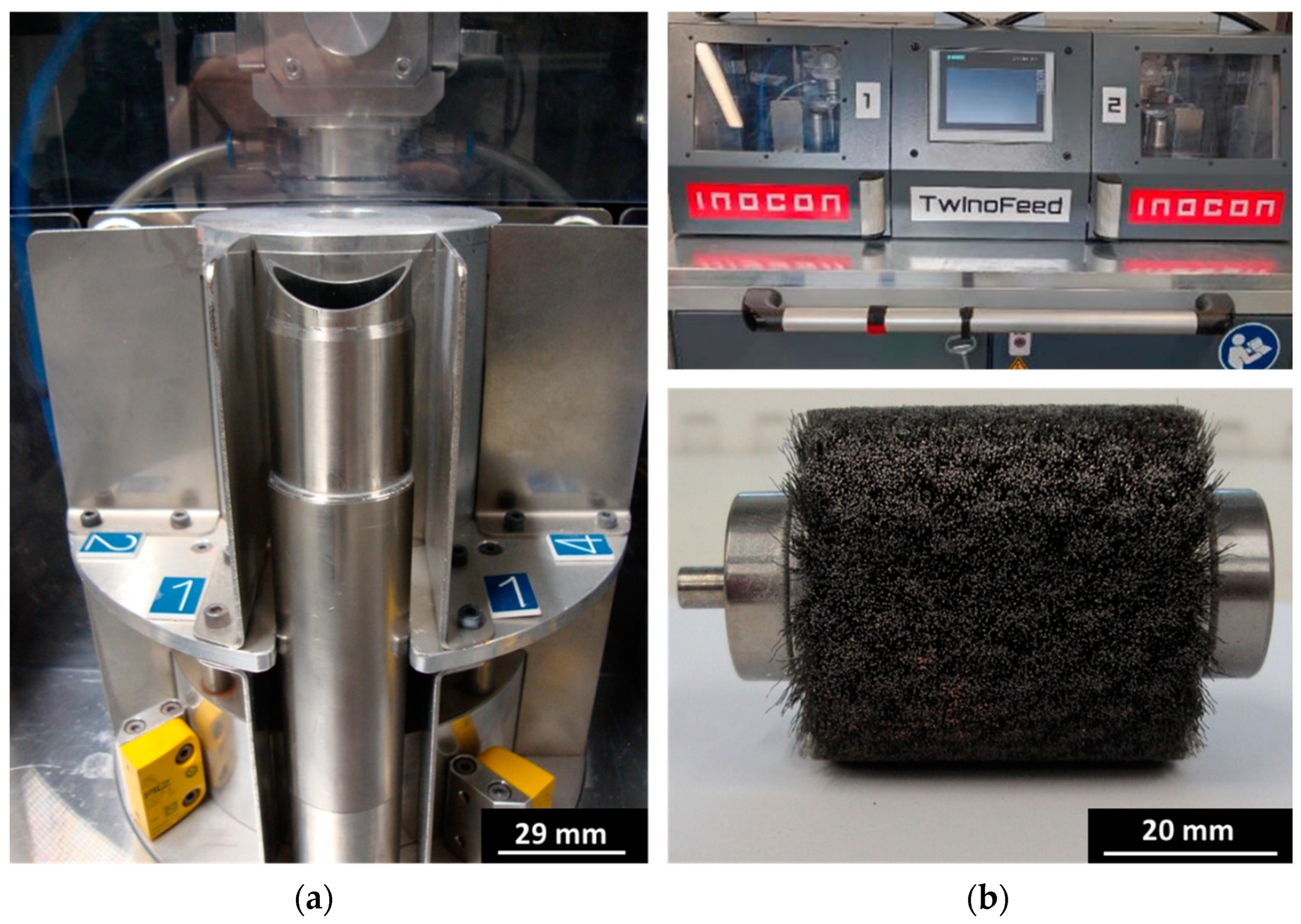

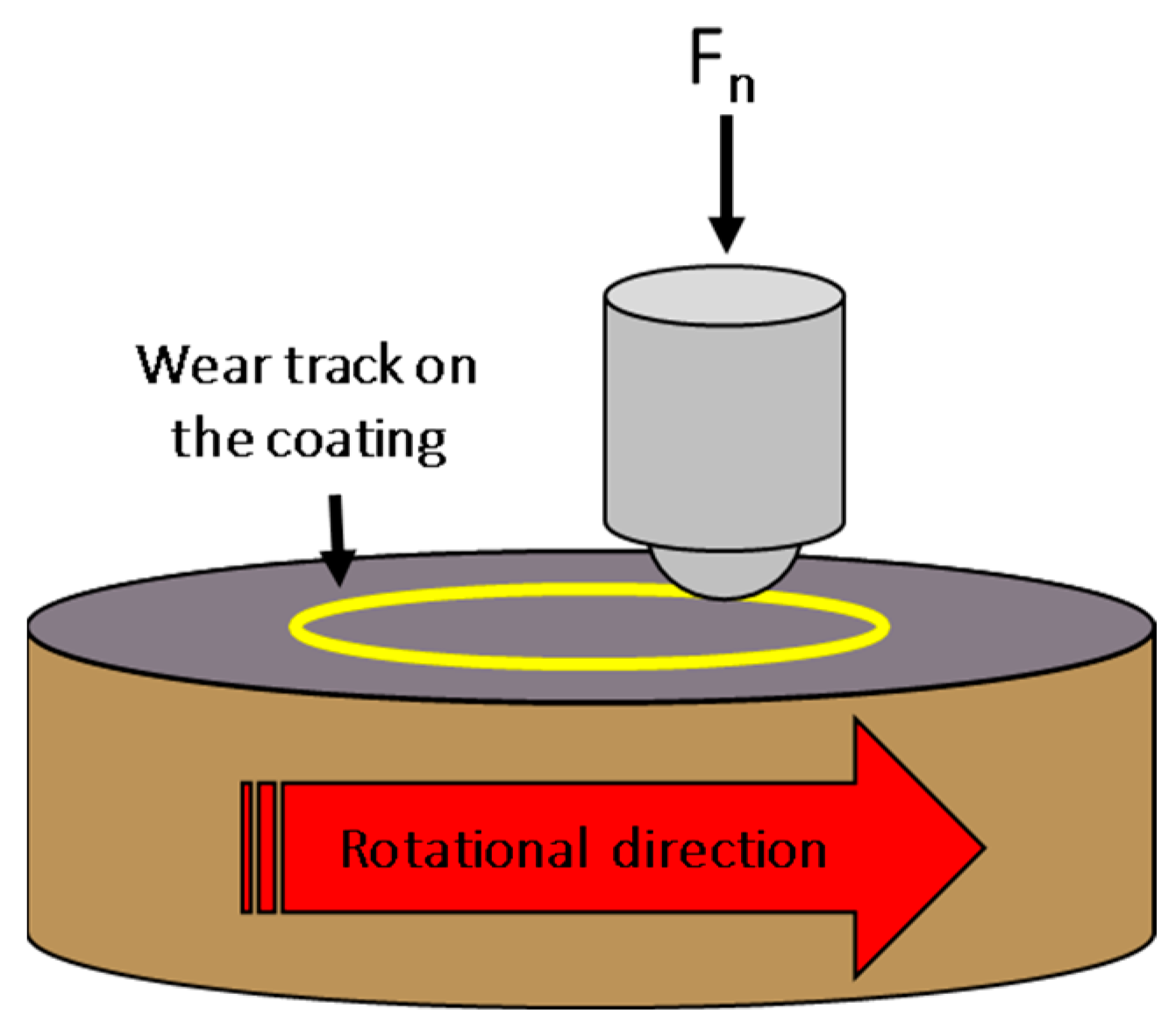

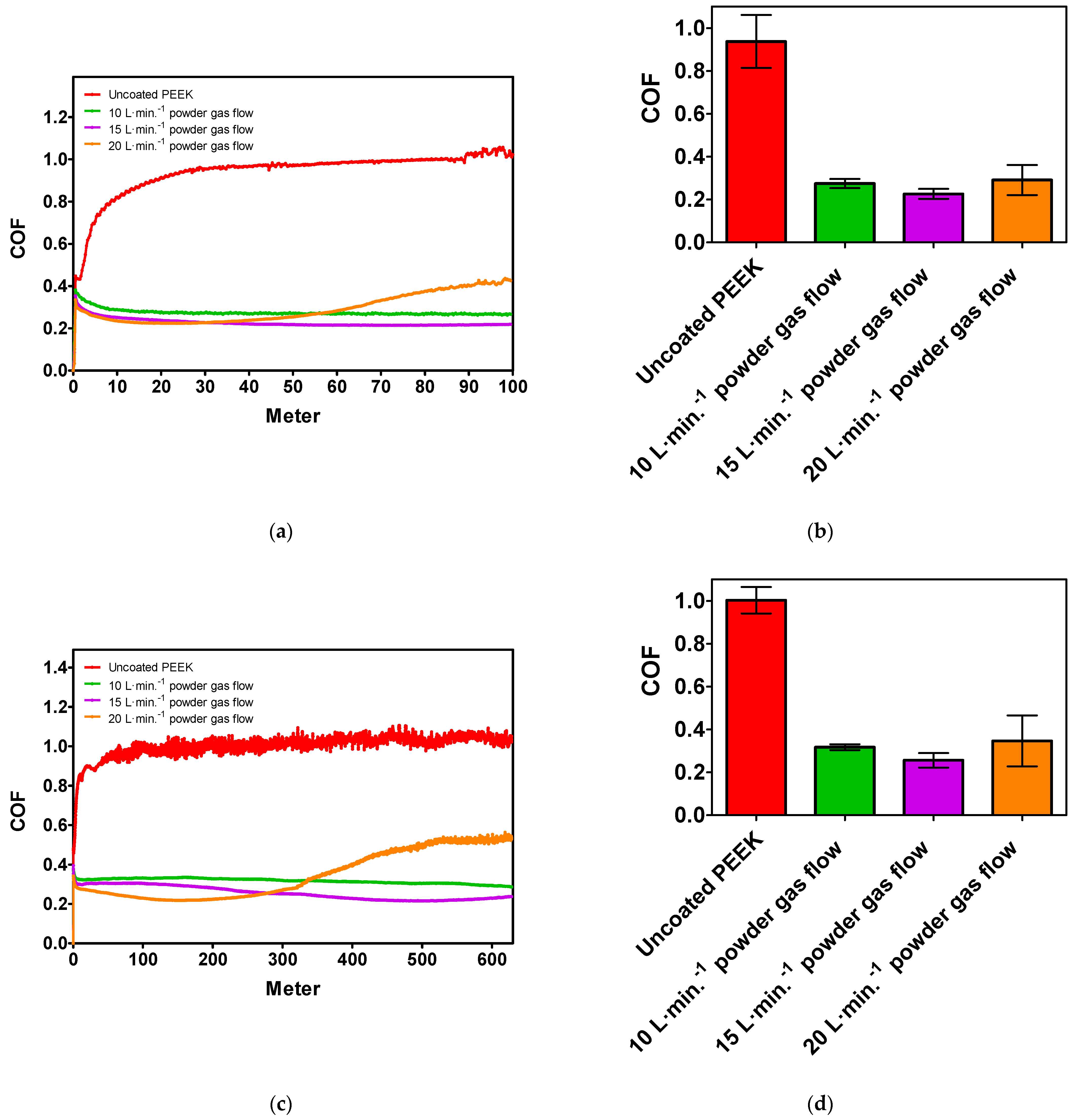
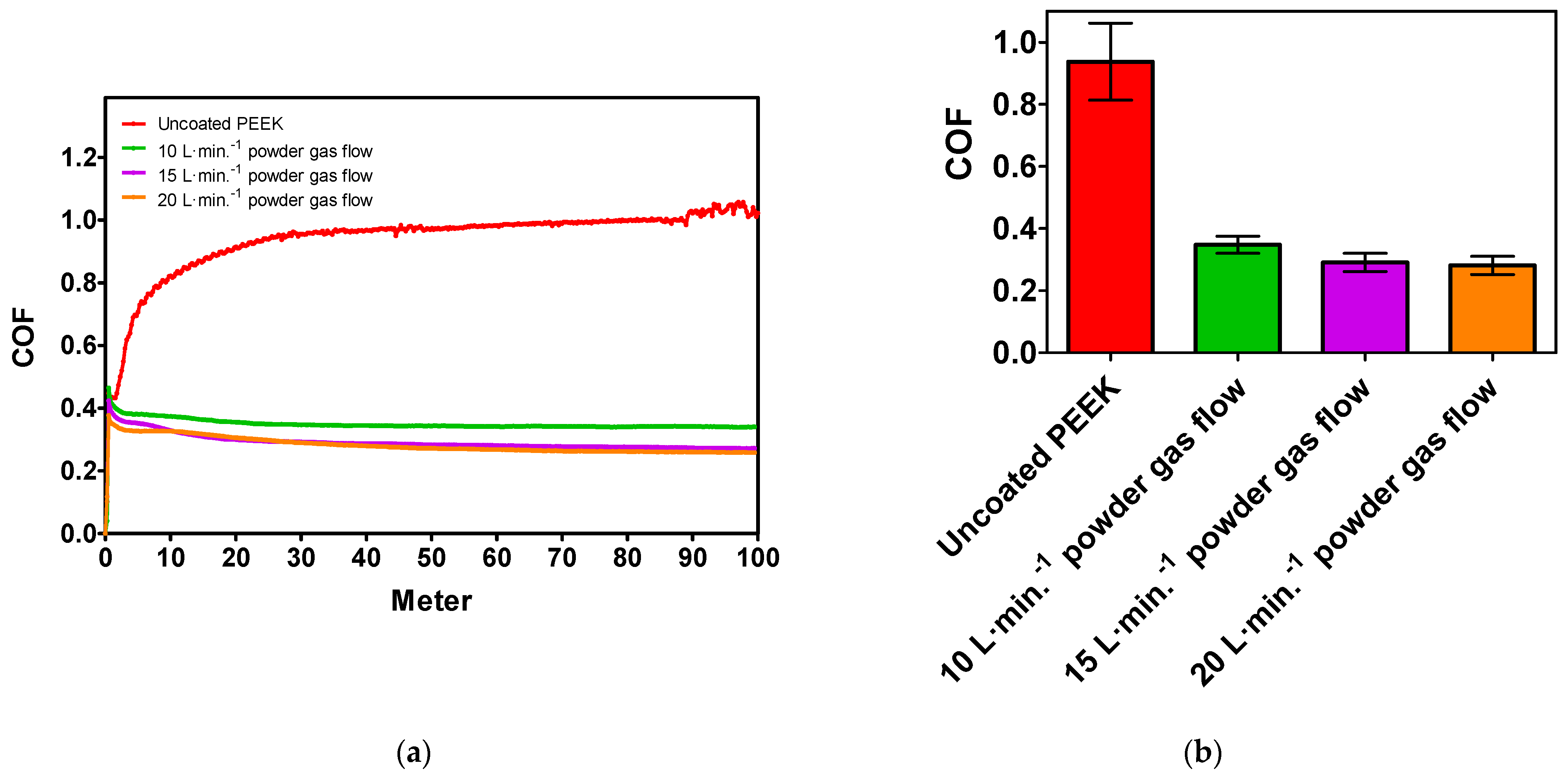
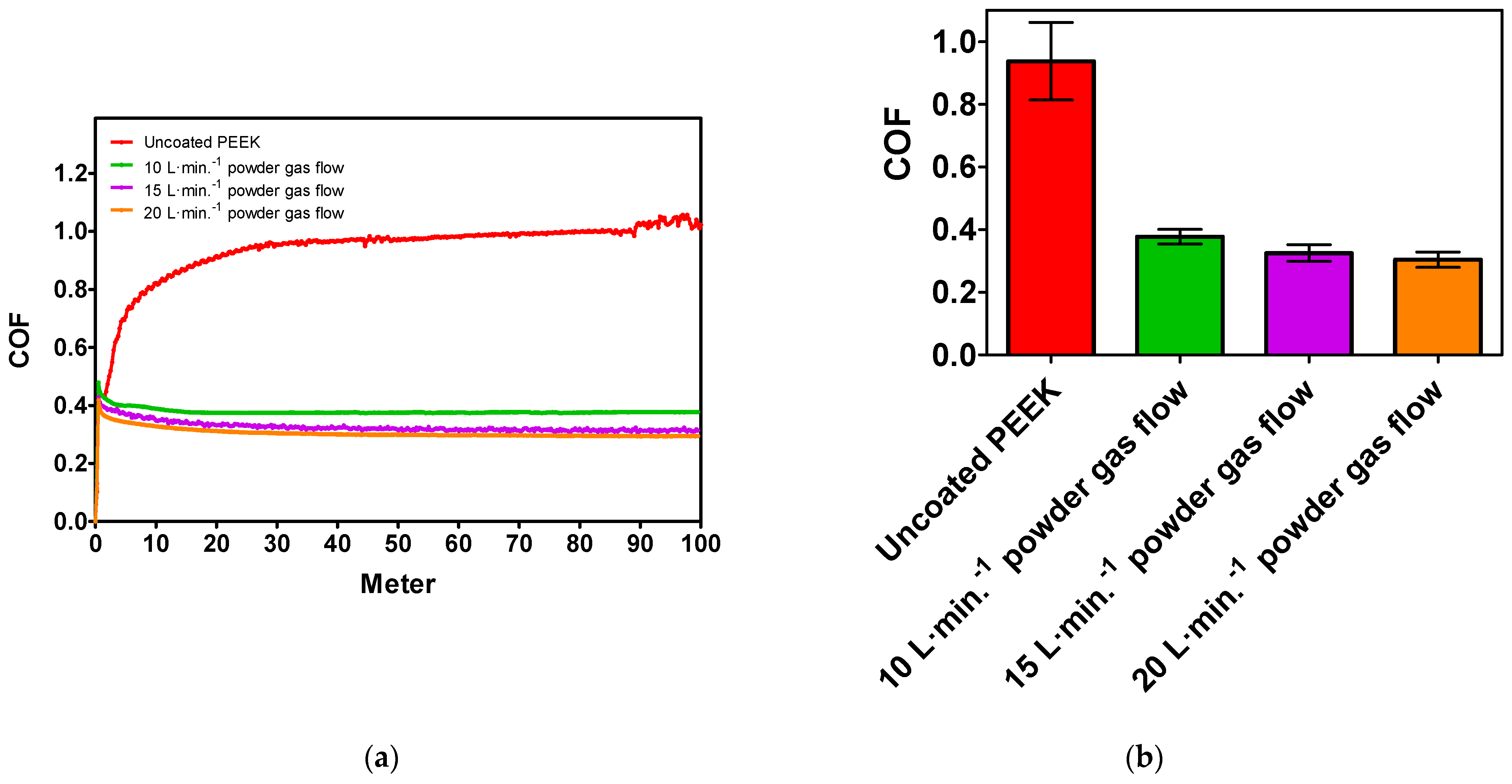
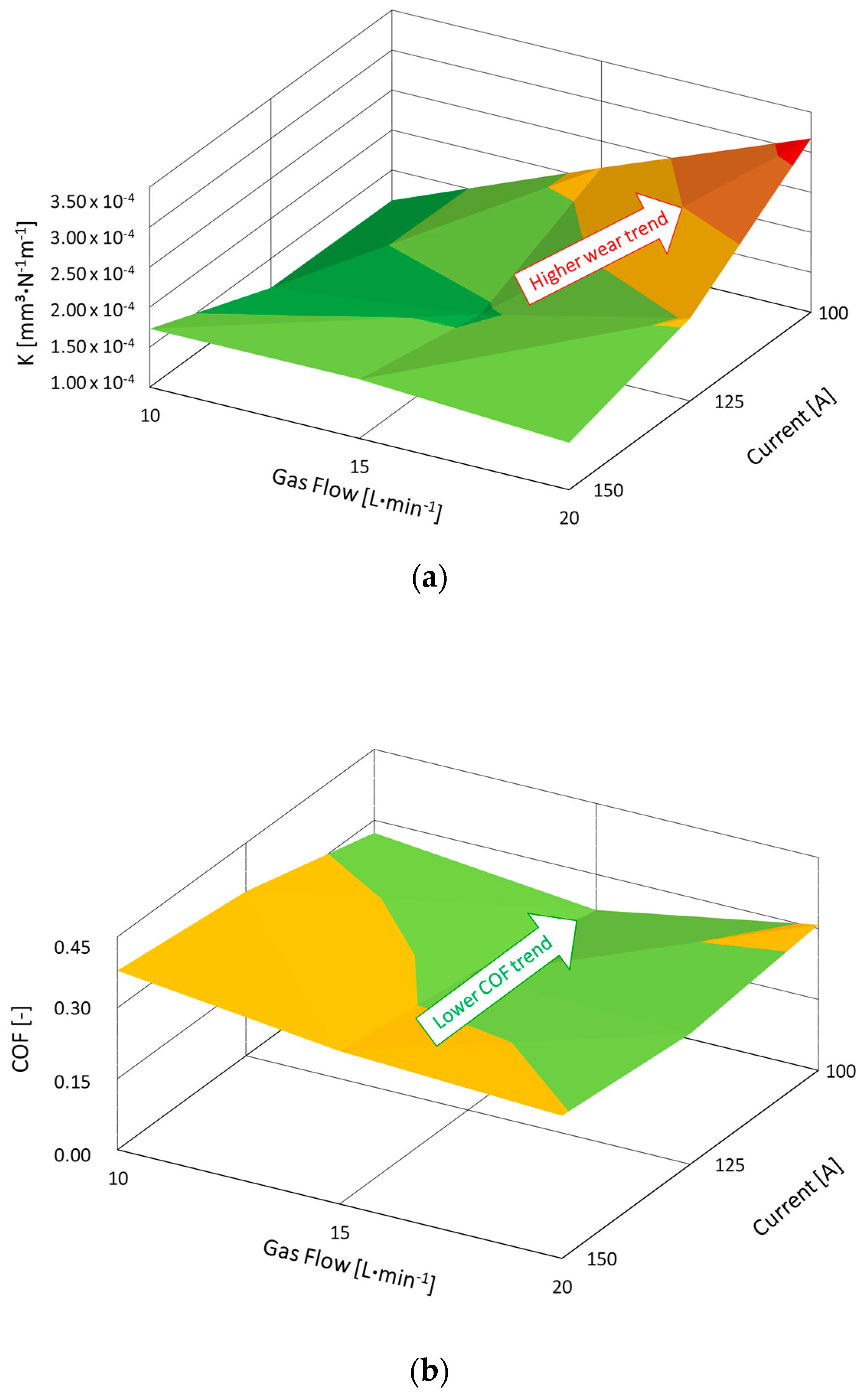
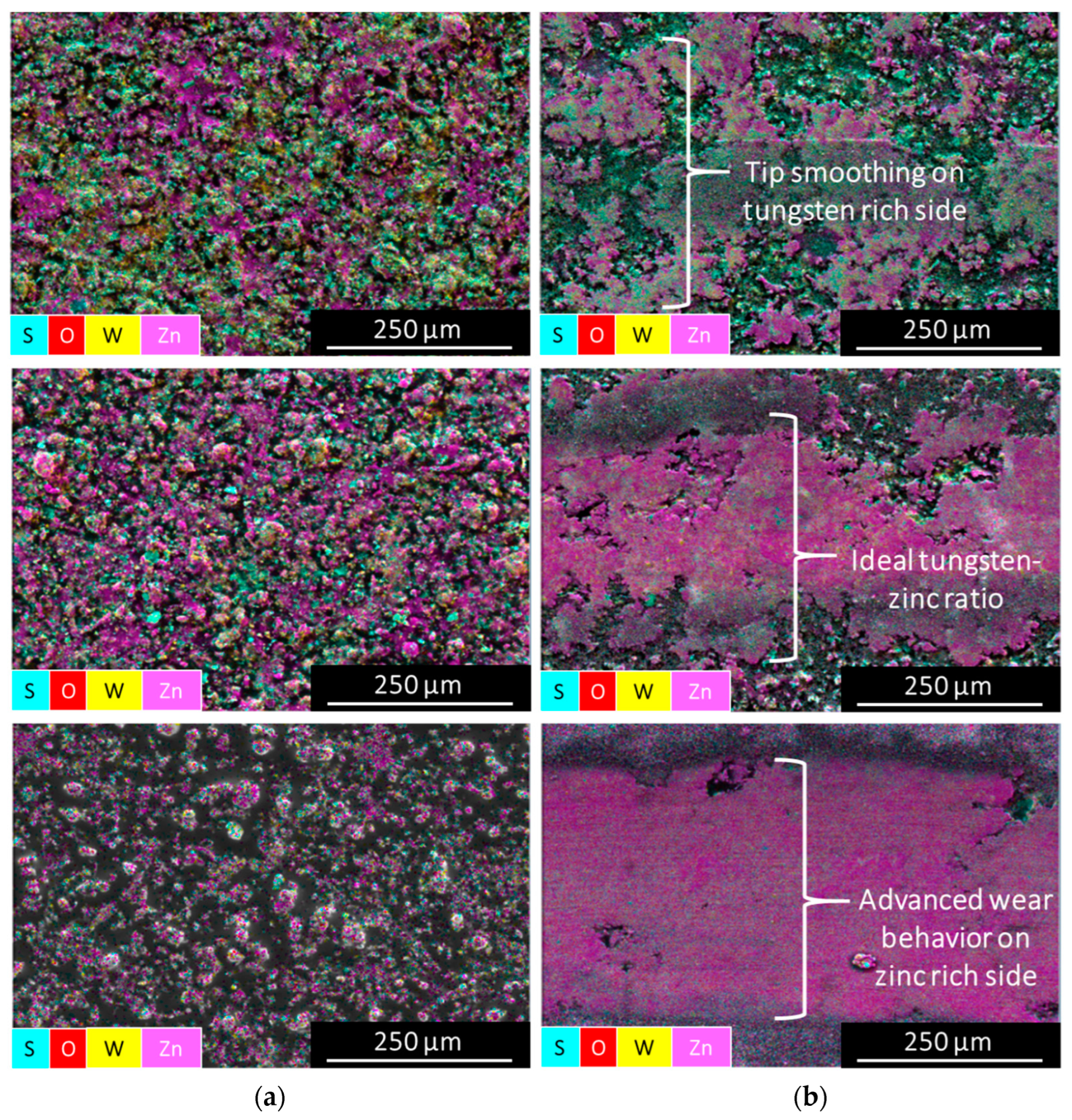
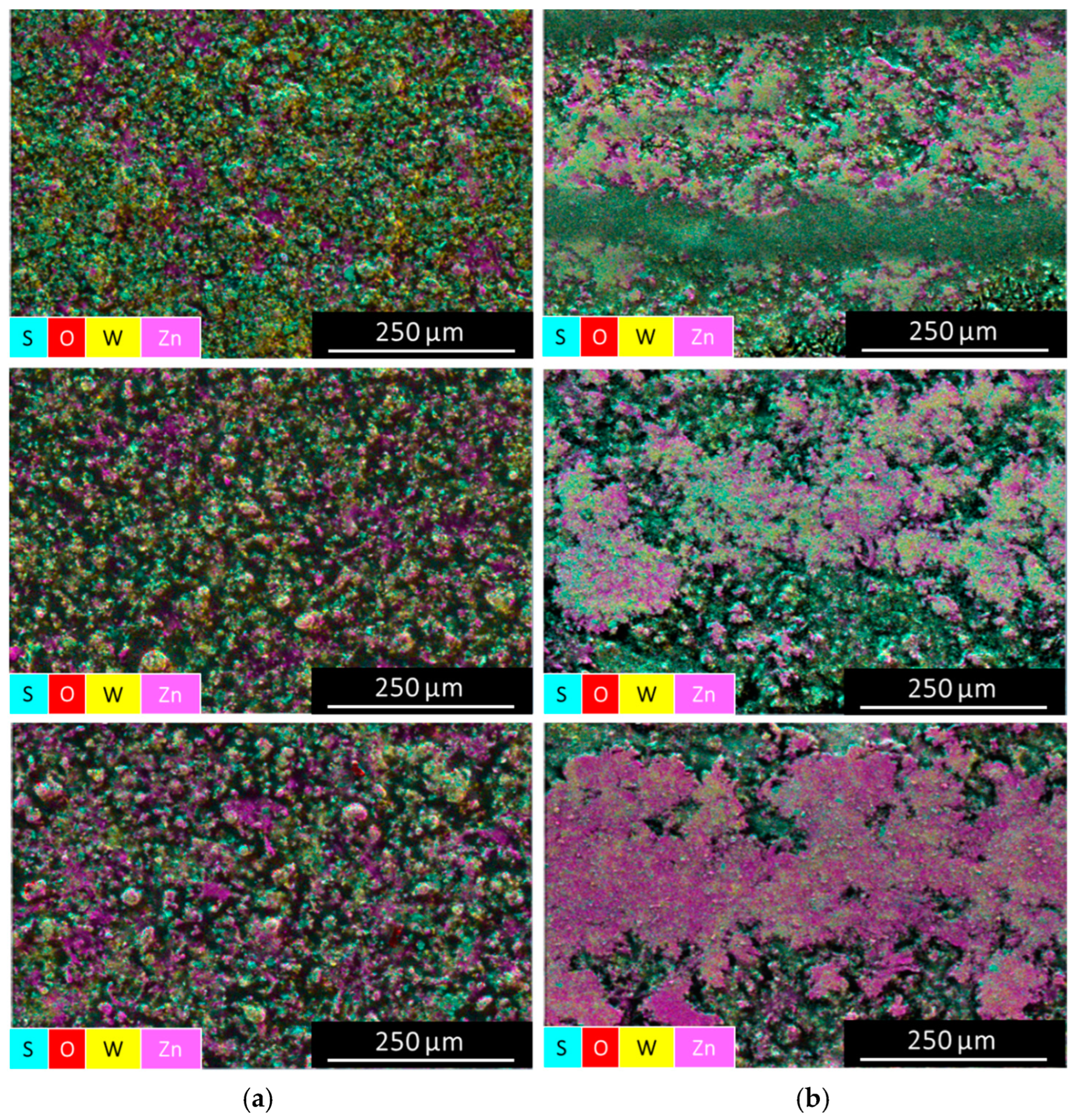
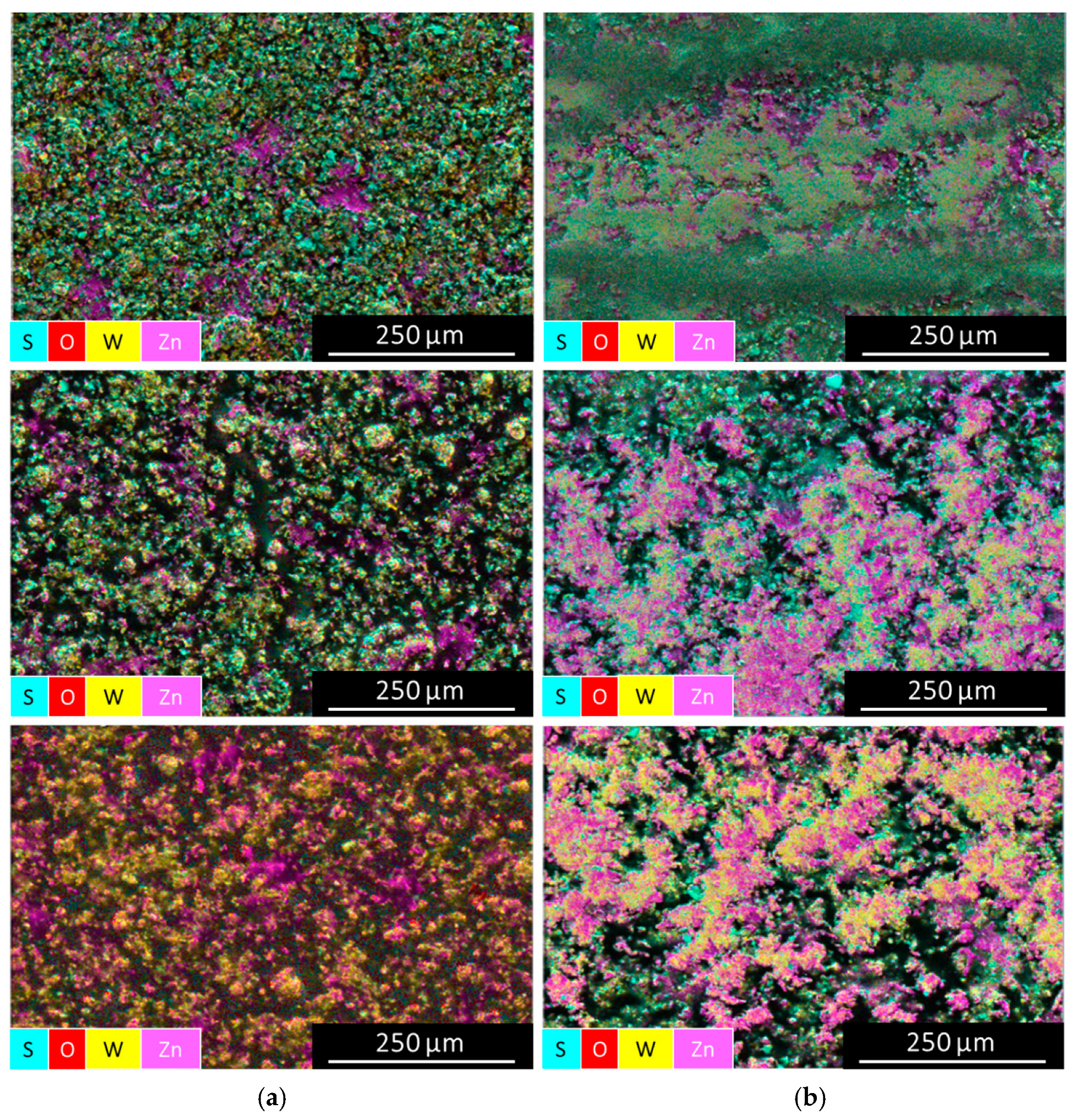
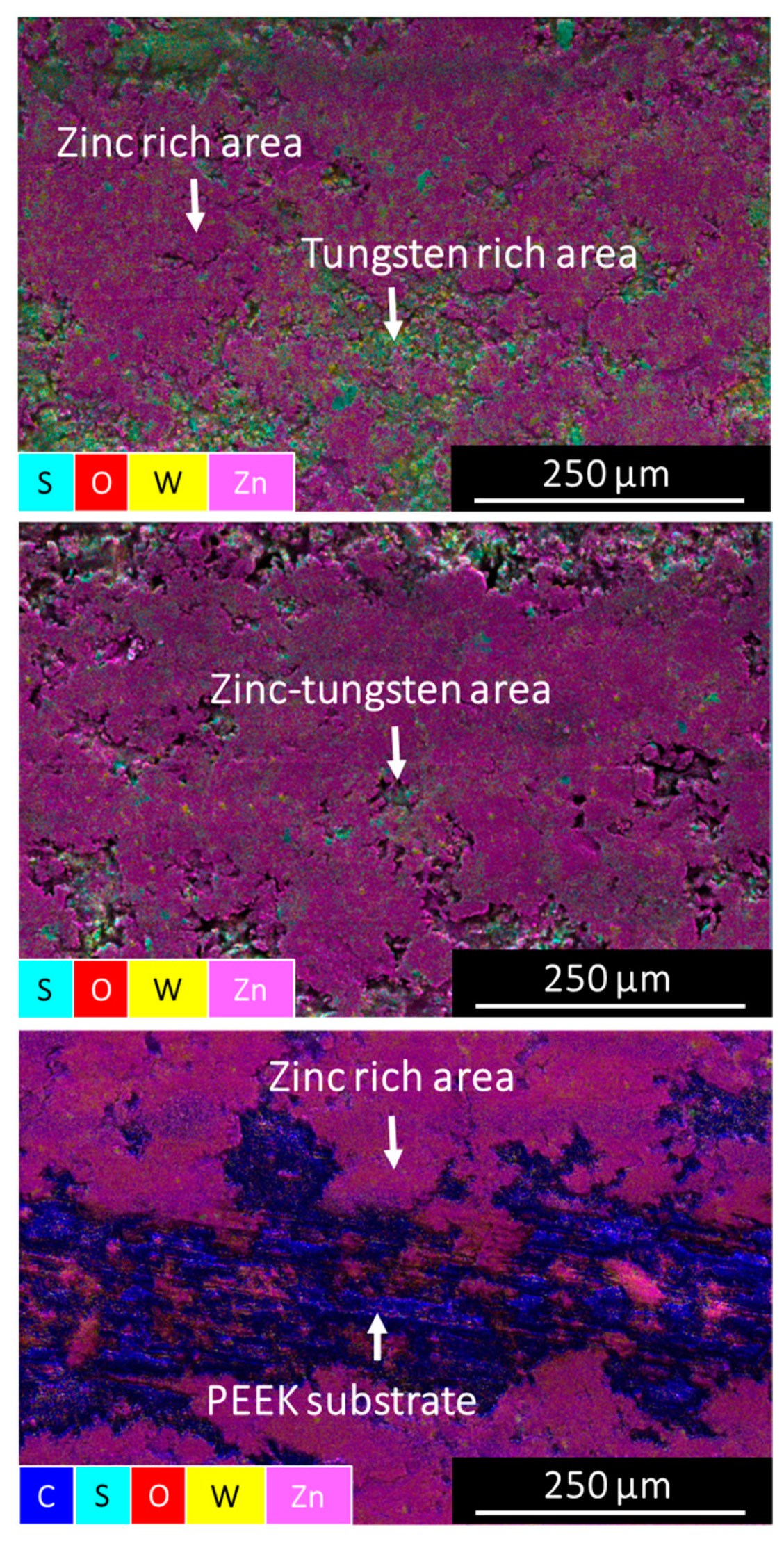

| APPJ Setting | Applied Parameter |
|---|---|
| Plasma jet current [A] | 100; 125; 150 |
| Powder gas flow [L·min−1] to the plasma | 10; 15; 20 |
| Plasma nozzle exit-substrate distance [mm] | 30 |
| Coating velocity [mm·s−1] | 200 |
| Linear coating passes [#] | 5 |
| Feedstock supply [g·min−1] | 2 |
| Ar gas flow [L·min−1] | 10 |
| N2 shrouding gas flow [L·min−1] | 20 |
| Wear Track Diameter | Linear Velocity | Static Counterpart | Test Length | Normal Load | Hertzian Stress |
|---|---|---|---|---|---|
| 10 mm | 25 mm·s−1 | 100Cr6 ball | 100 m | 1 N | 79 MPa |
| 20 mm | 25 mm·s−1 | 100Cr6 ball | 628 m | 1 N | 79 MPa |
| Sample Type/Coating Number | Ra (μm) | Coating Thickness (µm) |
|---|---|---|
| Uncoated PEEK | ≤0.50 | - |
| 100 A coating with 10 L·min−1 powder gas flow/E1 | 4.90 ± 0.92 | 16.14 ± 0.41 |
| 125 A coating with 10 L·min−1 powder gas flow/E2 | 4.14 ± 0.71 | 24.83 ± 0.12 |
| 150 A coating with 10 L·min−1 powder gas flow/E3 | 5.36 ± 0.88 | 25.98 ± 0.16 |
| 100 A coating with 15 L·min−1 powder gas flow/E4 | 4.89 ± 0.93 | 17.23 ± 0.15 |
| 125 A coating with 15 L·min−1 powder gas flow/E5 | 4.08 ± 0.67 | 18.99 ± 0.05 |
| 150 A coating with 15 L·min−1 powder gas flow/E6 | 4.58 ± 0.95 | 19.57 ± 0.04 |
| 100 A coating with 20 L·min−1 powder gas flow/E7 | 5.49 ± 1.18 | 14.32 ± 0.23 |
| 125 A coating with 20 L·min−1 powder gas flow/E8 | 4.56 ± 1.06 | 15.04 ± 0.11 |
| 150 A coating with 20 L·min−1 powder gas flow/E9 | 5.12 ± 0.84 | 22.17 ± 0.37 |
| SEM/EDS Analysis | wt% | |||||
|---|---|---|---|---|---|---|
| W | Zn | S | O | Fe | Total | |
| WS2-Zn as deposited of E1 | 61.0 | 30.5 | 5.5 | 3.0 | - | 100 |
| WS2-Zn wear track of E1 | 57.4 | 31.9 | 6.1 | 4.1 | 0.5 | 100 |
| WS2-Zn as deposited of E4 | 59.1 | 31.8 | 6.4 | 2.7 | - | 100 |
| WS2-Zn wear track of E4 | 50.8 | 36.7 | 8.2 | 4.2 | 0.1 | 100 |
| WS2-Zn as deposited of E7 | 53.5 | 37.6 | 5.7 | 3.2 | - | 100 |
| WS2-Zn wear track of E7 | 18.9 | 65.5 | 2.5 | 13.1 | <LOD | 100 |
| SEM/EDS Analysis | wt% | |||||
|---|---|---|---|---|---|---|
| W | Zn | S | O | Fe | Total | |
| WS2-Zn as deposited of E2 | 74.0 | 16.3 | 6.5 | 3.2 | - | 100 |
| WS2-Zn wear track of E2 | 69.1 | 19.0 | 6.7 | 4.3 | 0.9 | 100 |
| WS2-Zn as deposited of E5 | 73.1 | 18.3 | 7.6 | 1.0 | - | 100 |
| WS2-Zn wear track of E5 | 63.9 | 26.3 | 6.5 | 2.8 | 0.5 | 100 |
| WS2-Zn as deposited of E8 | 65.9 | 25.5 | 6.2 | 2.4 | - | 100 |
| WS2-Zn wear track of E8 | 48.5 | 42.4 | 4.9 | 4.0 | 0.2 | 100 |
| SEM/EDS Analysis | wt% | |||||
|---|---|---|---|---|---|---|
| W | Zn | S | O | Fe | Total | |
| WS2-Zn as deposited of E3 | 75.4 | 15.0 | 5.7 | 3.9 | - | 100 |
| WS2-Zn wear track of E3 | 71.3 | 16.4 | 5.9 | 5.1 | 1.3 | 100 |
| WS2-Zn as deposited of E6 | 74.8 | 17.2 | 6.4 | 1.6 | - | 100 |
| WS2-Zn wear track of E6 | 64.8 | 25.7 | 5.3 | 3.7 | 0.5 | 100 |
| WS2-Zn as deposited of E9 | 72.9 | 19.7 | 6.5 | 0.9 | - | 100 |
| WS2-Zn wear track of E9 | 62.5 | 28.3 | 4.7 | 4.1 | 0.4 | 100 |
| SEM/EDS Analysis | wt% | ||||||
|---|---|---|---|---|---|---|---|
| C | W | Zn | S | O | Fe | Total | |
| WS2-Zn wear track of E1 | - | 43.1 | 46.4 | 3.6 | 6.6 | 0.3 | 100 |
| WS2-Zn wear track of E4 | - | 27.5 | 61.3 | 2.6 | 8.5 | 0.1 | 100 |
| WS2-Zn wear track of E7 | 60.4 | 3.9 | 27.6 | 0.4 | 7.7 | <LOD | 100 |
| Feedstock | Coating E1 | Coating E4 | Coating E7 | |||||
|---|---|---|---|---|---|---|---|---|
| avg. | SD | avg. | SD | avg. | SD | avg. | SD | |
| S2p | 35.5 | 0.9 | 3.9 | 0.5 | 6.7 | 0.9 | 6.2 | 0.5 |
| W4f | 14.9 | 0.9 | 7.7 | 0.5 | 6.2 | 0.6 | 5.7 | 0.0 |
| O1s | 16.6 | 1.6 | 46.3 | 0.9 | 53.2 | 2.6 | 46.7 | 5.0 |
| C1s | 30.2 | 1.7 | 29.9 | 1.6 | 17.6 | 5.2 | 26.5 | 2.7 |
| Zn2p | 2.8 | 0.5 | 12.2 | 0.6 | 16.3 | 1.2 | 12.5 | 1.6 |
| Sample | G [GPa] | E [GPa] | K [GPa] |
|---|---|---|---|
| WS2-Zn (E1) | 0.51 ± 0.24 | 1.32 ± 0.64 | 1.10 ± 0.53 |
| Min–max. | 0.25–0.99 | 0.64–2.57 | 0.54–2.14 |
| WS2-Zn (E4) | 0.96 ± 0.59 | 2.49 ± 1.53 | 2.07 ± 1.28 |
| Min–max. | 0.53–2.43 | 1.39–6.31 | 1.16–5.26 |
| WS2-Zn (E7) | 0.26 ± 0.14 | 0.68 ± 0.36 | 0.57 ± 0.30 |
| Min–max. | 0.13–0.49 | 0.34–1.27 | 0.28–1.06 |
Disclaimer/Publisher’s Note: The statements, opinions and data contained in all publications are solely those of the individual author(s) and contributor(s) and not of MDPI and/or the editor(s). MDPI and/or the editor(s) disclaim responsibility for any injury to people or property resulting from any ideas, methods, instructions or products referred to in the content. |
© 2024 by the authors. Licensee MDPI, Basel, Switzerland. This article is an open access article distributed under the terms and conditions of the Creative Commons Attribution (CC BY) license (https://creativecommons.org/licenses/by/4.0/).
Share and Cite
Kopp, D.; Bandl, C.; Kaindl, R.; Prethaler, T.; Coclite, A.M.; Waldhauser, W. Shrouding Gas Plasma Deposition Technique for Developing Low-Friction, Wear-Resistant WS2-Zn Thin Films on Unfilled PEEK: The Relationship Between Process and Coating Properties. Coatings 2024, 14, 1365. https://doi.org/10.3390/coatings14111365
Kopp D, Bandl C, Kaindl R, Prethaler T, Coclite AM, Waldhauser W. Shrouding Gas Plasma Deposition Technique for Developing Low-Friction, Wear-Resistant WS2-Zn Thin Films on Unfilled PEEK: The Relationship Between Process and Coating Properties. Coatings. 2024; 14(11):1365. https://doi.org/10.3390/coatings14111365
Chicago/Turabian StyleKopp, Dietmar, Christine Bandl, Reinhard Kaindl, Thomas Prethaler, Anna Maria Coclite, and Wolfgang Waldhauser. 2024. "Shrouding Gas Plasma Deposition Technique for Developing Low-Friction, Wear-Resistant WS2-Zn Thin Films on Unfilled PEEK: The Relationship Between Process and Coating Properties" Coatings 14, no. 11: 1365. https://doi.org/10.3390/coatings14111365
APA StyleKopp, D., Bandl, C., Kaindl, R., Prethaler, T., Coclite, A. M., & Waldhauser, W. (2024). Shrouding Gas Plasma Deposition Technique for Developing Low-Friction, Wear-Resistant WS2-Zn Thin Films on Unfilled PEEK: The Relationship Between Process and Coating Properties. Coatings, 14(11), 1365. https://doi.org/10.3390/coatings14111365









